Abstract
The global situation concerning the incidence of infectious and non-communicable diseases emphasises the need for increased health literacy as an important aspect influencing health and life quality. Therefore, WHO has announced strategic plans to strengthen and coordinate these activities. In the Czech Republic, the strategic documents apply to all age and professional groups. A large part relates to the area of education. For these reasons, the authors performed a research study aimed at future teachers, whose health literacy is not affected by professional training but previous education. The paper presents the results of a research study on health literacy among students in the first grades of teacher training courses. The research was carried out in 2018/2019 and involved a representative sample of 253 students of the Faculty of Education, Palacký University Olomouc. The authors used a research instrument designed by WHO and provided by the National Institute of Public Health in Prague. The reliability is r=0.91. The results bring alarming findings. A total of 86.17% of students showed an inadequate level and 13.83% a problematic level of general health literacy. None of the respondents achieved an excellent or sufficient level. Students of Health education with a focus on education achieved a higher overall level of health literacy compared with students of other teacher training programmes, but without a statistically significant difference (p=0.10). Other surprising results concerned gender-based differences in the level of health literacy; men showed a higher level of health literacy than women, again without statistical significance (p=0.63).
Keywords: Health literacyfuture teachersHealth educationstudy programmesgender differences
Introduction
Health literacy involves a set cognitive and social skills which determine the motivation and ability of individuals to gain access to, understand and use information in ways which promote and maintain good health (WHO, 2014). This is an active and life enhancing skill, which is absolutely necessary to coordinate an individual in the modern society and to improve everyday health and well-being (Kickbusch, 2005). Studies conducted in 2007 (Baker, 2007) and 2008 (Cho, Lee, Arozullaha, Crittenden, 2008) confirm that poor health literacy deteriorates the health of the whole population (Altin, Finke, Kautz-Freimuth, & Stock, 2014). It is well known that the most frequent causes of morbidity and mortality are chronic non-communicable epidemics, which are directly related to lifestyle in developed countries of the world (Health, 2020, 2013) including the Czech Republic (Report on the health of the population of the Czech Republic, 2014). People with low health literacy often underestimate preventive measures and do not respect the principles of a healthy lifestyle.
Improving the health of the population and increasing the level of health literacy have become the top-priority strategic measures (Development of health literacy for 2015-2020, 2015). The content of the twelfth Action Plan (Development of health literacy for 2015-2020, 2015) is one of the long-term objectives to increase the level of health literacy to achieve at least the average level of other European countries with the aim of a real increase in health literacy. The key area is education including preschool education, elementary education, secondary vocational education and general grammar school education (Hřivnová, 2017; Hřivnová, Sofková, & Chrásková, 2019).
Problem Statement
Education in the area of health promotion and increasing health literacy involves a broad spectrum of knowledge and problems. The focus of this area is very broad and often exceeds the number of teaching units in various types of schools. There are areas however that make the teaching process clear and smooth. Holčík (2010) defines three representative domains of health education.
The first domain focuses on education with an emphasis on the patient and diseases. Attention is especially on precise diagnoses and particularly somatic manifestations of diseases. This information should usually be communicated by a medically educated person and should result in motivation and development of opinions and beliefs concerning responsible behaviour towards one’s health. The result of this domain should be awareness of the ability to influence one’s health, relevant changes in behaviour, and acceptance and comprehension of what is being communicated.
The second domain focuses on risk factors, both in a general and specific context. The main point in this respect is lifestyle, which is the basis of most risks. The principle of this domain is encouragement for a better lifestyle, i.e. a higher proportion of physical activity, limiting or eliminating habit-forming substances, healthy diet, including the effect of social issues on health.
The third domain is health education focused on health in terms of its value. This value should be appreciated and any negative behaviours leading to diseases should be avoided. It is not primarily about enforcing a change in behaviour but rather about offering other ways to treat oneself and achieve a better bio-psycho-social condition (Holčík, 2010).
Janovská (Janovská et al., 2016) defines three areas of health literacy (referred to as HL) in terms of improved everyday life. The first area is health promotion. This area focuses on the essential aspects of lifestyle and environmental behaviour. The second area focuses on disease prevention and comprises ways of preventing infectious and chronic diseases as well as evidence based medicine. The third area is healthcare. This objective of this area is to introduce healthcare and first aid competences.
In order to promote high-quality use of health literacy, an algorithm was developed that supports the development of HL in everyday life. The algorithm comprises three terms “I want – I know – I can”, which represent the key points in the quest for a higher quality of life and health. The term concept “I want” represents internal motivation at any age. The term “I know” represents the ability of an individual to possess the crucial knowledge and skills. At the same time it represents the ability to understand, evaluate and process all information and values and include them into the reality of everyday life. The third term “I can” represents all external conditions for the application and realization of all knowledge and skills.
Research Questions
The following research questions were formulated for the purposes of the research:
What is the level of general health literacy among students enrolling in the first grade of teacher training courses?
What is the proportion of students enrolling in the first grade of teacher training courses who achieve the highest level of health literacy?
Do students of Health education with a focus on education have a higher level of general health literacy than students of other study programmes?
Do female students enrolling in the first grade of teacher training courses achieve a higher level of general health literacy than male students?
Purpose of the Study
The purpose of the research is to analyse the level of general health literacy among students enrolling in the first grade of teacher training courses at the Faculty of Education, Palacký University Olomouc (referred to as PdF UP). The partial objectives are to compare the achieved level of general health literacy in relation to the study programme and gender. The formulation of the objectives was based on the general expectation of the society that teachers adequately improve various literacies of their students in the context of education. The authors were interested in the level of health literacy at the beginning of university study after completion of primary and secondary education, and whether this entry-level differs between students enrolling in a study programme aimed at health education and students in different study programmes. From a historical and gender perspective, a higher level of health literacy is attributed to women as opposed to men (Kickbusch, Pelikan, Apfel, & Tsouros, 2013). The present research aims to explore whether this premise is confirmed with a statistically significant result.
Research Methods
The present research exploring the level of health literacy among students enrolling in the first grade of Bachelor’s teacher training courses at PdF UP used a standardized questionnaire designed by the WHO and provided by the National Institute of Public Health in Prague (Kučera, Pelikan, & Šteflová, 2016). The applicable data analysis methodology was observed.
Description of the research sample
The research sample comprised 288 students in the first grades of Bachelor’s teacher training courses at PdF UP. The respondents were future teachers who will affect the level of various literacies including lifestyle and health literacy in their future students. The research study was conducted at the Faculty of Education, Palacký University Olomouc in the academic year 2018/2019. Regarding the fact that 35 respondents did not meet the requirements for questionnaire analysis determined by standardization (maximum number of responses “I don’t know”, see part 5.2.), the final research sample comprised 253 respondents. For the purposes of the study, the research sample was divided into two groups; one of them comprised students of Health education with a focus on education, whose field of study is saturated by disciplines aimed at health promotion and health education and focuses on qualification in Health education in elementary schools and development of learners’ health literacy (in the table identified as HE). The other group comprised students in the first grade of Bachelor’s study programmes not dominated by developing health literacy among elementary school students. A detailed description of the research sample by gender and field of study is specified in Table
Health literacy questionnaire
The research was performed by means of the health literacy questionnaire designed by the World Health Organization, which was also used in 2016 to examine the level of health literacy among the citizens of the Czech Republic (Kučera, Pelikan, & Šteflová, 2016). This is a standardized research instrument used to measure the level of general health literacy as well as its partial dimensions. The tool measures the following: HL in the area of health care, HL in the area of disease prevention, and HL in the area of health promotion. For the purposes of the present research study the instrument was provided by the Institute of Public Health in Prague, specifically the Centre for public health promotion, which has been a long-standing partner of PdF UP Olomouc. For the purposes of the present research, the original “structured interview” method was changed into a written questionnaire. In the process of data evaluation, the required standardized methodology was strictly observed (Kučera, Pelikan, & Šteflová, 2016). The indexes of the HL dimensions (HL in the area of healthcare HC-HL, HL in the area of disease prevention DP-HL, HL in the area of health promotion HP-HL and general level of health literacy GHL) have values from 0 to 50 points divided into four health literacy intervals: Inadequate (0-25 points); Problematic (26-33 points); Sufficient (34-42 points) and Excellent (43-50 points).
General health literacy (GHL) was assessed using the GHL index. This was calculated based on the responses to questions Q1/1-47; only those respondents were included who indicated a maximum of four responses “I don’t know” of the 47 cases.
Prior to the analysis of the results the reliability of the questionnaire was determined by means of Cronbach’s alpha. The calculated overall reliability of the health literacy questionnaire was r=0.91, which indicates a very high reliability of the measurement tool. For the purposes of completeness the reliability of individual parts of the questionnaire was determined – see Table
The t-test statistical method was used for data processing. The research data were processed by means of the STATISTICA 13 package including relevant graphs (Histogram and Box & Whisker Plot). This paper analyses the partial data relating to the evaluation of the overall level of students’ health literacy.
Findings
General health literacy (GHL) in students at PdF UP at the beginning of their study in the first grade
The distribution of students’ general health literacy (GHL index) is shown in Figure
The low level of health literacy in university students was also suggested by Jarolímek & Lustigová (2018), who performed a research study on a sample of 286 respondents aged 18 to 30 years and observed that the worst area was health literacy. The authors emphasise that not even the benefit of the modern information society together with the availability of information and the level of achieved education affect young people’s attitude to their own health.
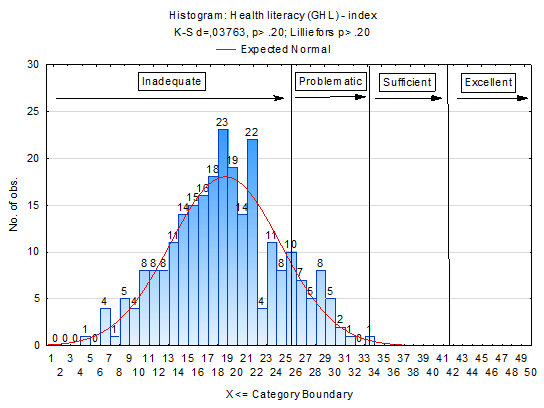
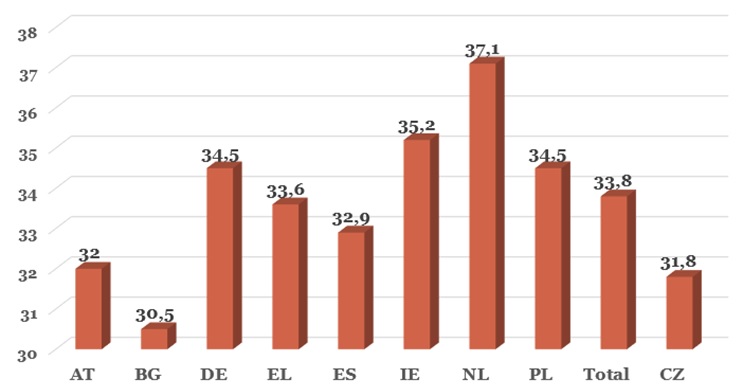
Observed level of general health literacy (GHL) among students at PdF UP at the beginning of their study in the first grade
The level of general health literacy by categories among students at PdF UP at the beginning of their study in the first grade is presented in Figure
A comparison of the present results with a study aimed at health literacy among the citizens of the CR (Kučera, Pelikan, & Šteflová, 2016) – see Figure
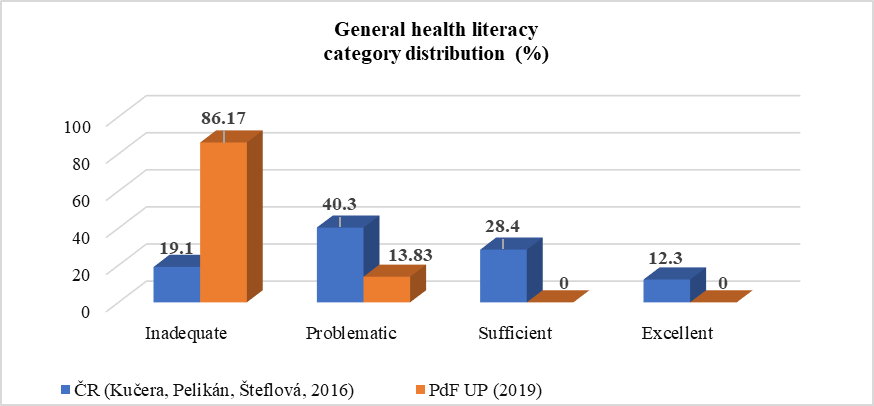
General health literacy (GHL) in students at PdF UP at the beginning of their study in the first grade by study programme
The next part of the research study focused on whether students of Health education with a focus on education had a higher level of general health literacy than students of other study programmes. Regarding the fact that the measured data showed normal distribution (see Figure
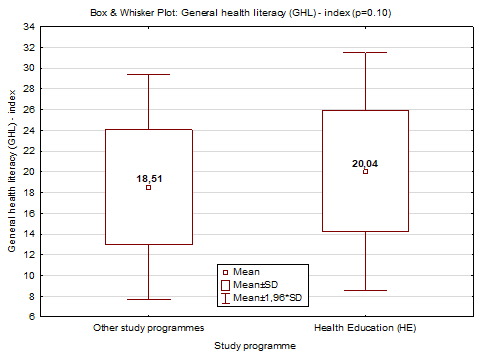
General health literacy (GHL) in students at PdF UP at the beginning of their study in the first grade by gender
The analysis of the data obtained (similarly to part 6.3) resulted in somewhat surprising conclusions, see Figure
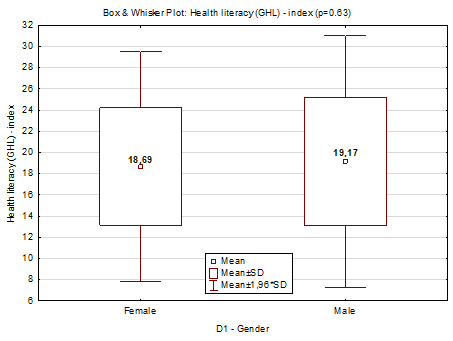
The expectation that female students enrolling in the first grade of teacher training courses achieve a higher level of general health literacy than male students was disproved. Men achieved a higher level of general health literacy than women, but again this difference is not statistically significant (p=0.63). However, this points to a trend suggesting that healthcare is no longer the domain and priority of only women but also men.
Conclusion
Currently, the development of health literacy should be a priority initiative in the context of improving health and quality of life of all population groups. HL can be increased in several ways. Depending on the differences between various target groups, adequate methods must be selected. Health literacy has its roots in education, but primarily in the family. This can be used as a basis for the development of health habits and abilities in the educational process. An important way to increase the level of health literacy is also consistent delivery of Health education across the entire educational system, including the development of learners’ social and personality development. It has been confirmed that learners who do not appreciate themselves are later in life threatened by an unhealthy lifestyle, alcohol, drugs, or other non-substance addictions. An individual who feels unable to influence one’s fate does not have positive life prospects (Holčík, 2010).
The current low level of general health literacy among students enrolling in teacher training courses emphasises a need to support HL education in the context of tertiary education. This applies to students of all study programmes in educational modules of the so-called general course not only on a propaedeutic level, but also with the aim of deepening their expertise and attitudes in this area. The low level of HL obviously increases the risk of diseases, their recurrences, and premature death. Unfortunately, it also often leads to a significantly lower use of available preventive programmes and medical examinations. This results in poor cooperation of patients during examinations and medical treatment with both non-medical and medical staff (Čeledová & Holčík, 2017), which logically leads to higher expenditure.
Acknowledgments
The paper was supported by the Grant Fund of the Dean of the Faculty of Education, Palacký University Olomouc GF_PdF_2019_0001 “Lifestyle and health literacy among future teachers”.
References
- Altin, S.V., Finke, I., Kautz-Freimuth, S., & Stock, S. (2014). The evolution of health literacy assessment tools: a systematic review. BMC Public Health, 14, 1-13.
- Baker, D. W. (2007). Health Literacy and Mortality Among Elderly Persons. Archives of Internal Medicine, 167(14), 1503-1509.
- Čeledová, L., & Holčík, J. (2017). Nové kapitoly ze sociálního lékařství a veřejného zdravotnictví [New Chapters from Social Medicine and Public Health]. Praha: Karolinum.
- Cho, Y. I., Lee, S-Y. D., Arozullaha, A. M., & Crittenden, K. S. (2008). Effects of health literacy on health status and health service utilization amongst the elderly. Social Science & Medicine, 66(8), 1809-1816.
- Health 2020. (2013). A European Policy Framework and Strategy for the 21st Century. Copenhagen: World Health Organization, Regional Office for Europe.
- Holčík, J. (2010). Systém péče o zdraví a zdravotní gramotnost: k teoretickým základům cesty ke zdraví [Health Care System and Health Literacy: The Theoretical Basis of the Path to Health]. Brno: Masarykova univerzita.
- Hřivnová, M. (2017). Zdravotní gramotnost v profesní přípravě pedagogů [Health literacy in teacher training]. Preventivní programy v ošetřovatelské péči: sborník 12. Vědecké mezinárodní konference (pp. 12-18). Praha: Vysoká škola zdravotnická. Available from http:// www.vszdrav.cz/ userdata/files/ VSZ_konference_sbornik_2017.pdf
- Hřivnová, M., Sofková, T., & Chrásková, M. (2019). The Importance of Developing Health Literacy in Undergraduate Teacher Training in the Czech Republic. VI. International Multidisciplinary Scientific Conference Social Sciences & Arts Sgem 2019. 24. Aug. – 2. Sept. 2019. In press.
- Janovská, K., Jakubalová, S., Křistek, N., Mikšová, Z., Nováková, S., … Wasserbauer, S. (2016). Zdravotní gramotnost dětí, mladých dospělých, dospělých, senior. [Health Literacy of Children, Young Adults, Adults, Seniors]. Praha: Národní síť podpory zdraví.
- Jarolímek, J., & Lustigová, M. (2018). Zdravotní gramotnost je i u mladých vysokoškoláků stále velmi nízká. [Health Literacy Is Still Very Low among Young University Students]. Praktické Lékařství, 98(1), 12-17.
- Kickbusch, I., Pelikan, J. M., Apfel, F., & Tsouros, A. D. (2013). Health literacy. The solid facts. Copenhagen: World Health Organization.
- Kickbusch, I. (2005). The Health Society: Importance of the new policy proposal by the EU Commission on Health and Consumer Affairs. Health promotion international, 20, 101-103.
- Kučera, Z., Pelikán, J., & Šteflová, A. (2016). Zdravotní gramotnost obyvatel ČR − výsledky komparativního reprezentativního šetření [Health literacy of the Czech population - results of a comparative representative survey]. Časopis lékařů českých, 5, 233-241.
- Rozvoj zdravotní gramotnosti na období 2015–2020 [Development of health literacy for the period 2015-2020]. (2015). Praha: Ministerstvo zdravotnictví. Retrieved from http://www.mzcr.cz/Admin/ upload/files/5/ak%C4%8Dn%C3%AD%20pl%C3%A1ny%20%20p%C5%99%C3%ADlohy/ AP%2012%20rozvoj%20zdravotn% C3%AD%20gramotnosti.pdf
- WHO, 2014. (2014). Basic Documents. Fourty-eigth Edition. Geneva: World Health Organization.
- Zpráva o zdraví obyvatel České republiky [Report on the health of the population of the Czech Republic]. (2014). Praha: Ministerstvo zdravotnictví České republiky.
Copyright information

This work is licensed under a Creative Commons Attribution-NonCommercial-NoDerivatives 4.0 International License.
About this article
Publication Date
07 November 2019
Article Doi
eBook ISBN
978-1-80296-071-6
Publisher
Future Academy
Volume
72
Print ISBN (optional)
-
Edition Number
1st Edition
Pages
1-794
Subjects
Psychology, educational psychology, counseling psychology
Cite this article as:
Chraskova, M., Hrivnova, M., & Sofkova, T. (2019). Health Literacy Level Among Future Teachers At The Beginning Of Undergraduate Education. In P. Besedová, N. Heinrichová, & J. Ondráková (Eds.), ICEEPSY 2019: Education and Educational Psychology, vol 72. European Proceedings of Social and Behavioural Sciences (pp. 430-439). Future Academy. https://doi.org/10.15405/epsbs.2019.11.52

